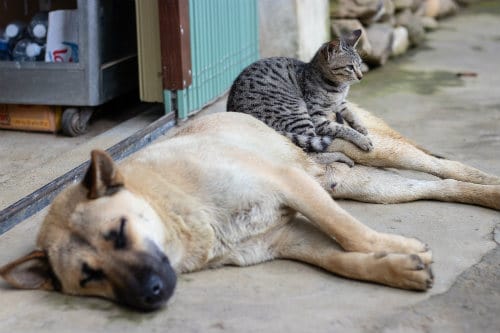What’s at the Root of the Trouble?
Both dogs and cats are great companions, but sometimes it’s hard for them to co-exist under the same roof without fights due to behavioral differences.
Many pet owners don’t think about both species evolving differently and having unique relationships with humans that can influence how they interact with each other.
However, bringing peace between your dog and cat is possible with persistence.
There are a few factors that contribute to dog aggression towards household cats, usually ones that are easy to resolve.
These may range from improper introductions to a fearful or abused dog acting out.
Because there are different causes, it’s essential to understand what the reason is for the aggression to tackle it better.
Proper Introductions

Many cases of aggression stem from dogs and cats not having had proper introductions.
Dogs are very responsive to new smells and might see a new cat whose smell they aren’t used to as a sort of intruder.
Separating the two pets until the dog has a chance to get accustomed to the cat’s scent can help prevent some of the aggression.
Keeping a closed door in between the two pets is preferable to a gate, as cats can quickly get over most barriers.
When there’s a closed door, they can smell and hear each other, without having a situation where they can fight.
You will also avoid any problems that might happen because of the cat approaching the dog while he or she is eating, which is a severe problem with food-aggressive dogs.
[amazon bestseller=”cat automatic feeder timed”]
Never allow a dog and cat to interact with the dog unleashed if they are unaccustomed to each other or the dog has required refresher training.
Food rewards can be helpful for rewarding friendly behavior, and provide a positive association.
However, it’s a good idea to watch for signs of hostility from your dog, such as snarling, raised hackles, or a defensive posture that the cat may not see as threatening.
Early Signs of Trouble
One of the first signs of trouble between your dog and cat that you might notice is your dog trying to chase the cat, especially if they are a breed with a high prey drive.
If tolerated, this might escalate into more severe aggression, including biting and mauling.
Keeping both pets separated until you can seek out obedience training is a must if chasing attempts happen or you notice another aggressive behavior present.
It also helps if you can spot the difference between play that seems aggressive and actual aggression on your dog’s part.
Even if your dog’s behavior is more play-based, a large dog could injure or kill a cat from rough play.
When your dog plays rough and is unresponsive to your commands, obedience training, and closer supervision are in order.
Taking charge of a situation with aggression early on can help prevent attacks that result in an injured cat.
Even if there has been no history of trouble between the pets, changes in the household that are stressful for a dog might trigger problems.
When these problems arise, quick action to help prevent further aggression is necessary for the sake of both animals.
Obedience Training

Obedience training is useful for the dog, but for you as the owner as well.
Proper training will help you maintain your position as the dog’s boss as well as teach him or her how to behave around the cat.
When a dog understands what is or isn’t appropriate behavior, you will see fewer problems.
Knowing how to control your dog’s behavior around cats can also have some serious safety benefits for your dog.
Even the most good-natured cat could turn aggressive if exposed to too much aggression from a dog.
Preventing such incidents is a lot easier than dealing with two animals being at enmity with each other.
Dogs have a natural pack structure, where they look to their owners as leaders.
Because they are different from cats in this respect, they require some guidance to better understand how the cat fits into the pack.
A dog that understands the cat’s place in the family, and most importantly, its owner’s authority, will be less likely to act out against the cat.
One Command That Helps
Teaching dogs the command “Leave it” is an effective way to start training the dog to ignore the cat while leashed.
Distracting your leashed dog with a treat or other stimulus when the cat is nearby while using this phrase takes his or her attention away from your other pet.
If you’re consistent about using this command around your dog, he or she will respond both on and off-leash.
“Leave it” is a command that could also help save your dog’s life.
A tragic consequence of dogs chasing cats can be the dog chasing a cat into the street and getting hit.
Chasing should always be treated as aggressive behavior that you do not tolerate as an owner.
When this command is used as often as possible around the cat, your dog will come to understand that they should leave the cat alone.
Even if your dog ignores the cat most of the time instead of interacting with him or her, this is still preferable to hostile behavior.
When the dog sees the cat as another part of the family, they will be less likely to hurt him or her.
[amazon bestseller=”cats tree house tower”]
Keeping Playtime Safer

Keeping interactions between the two pets to a few minutes at a time will help reduce the chances of hostilities.
The two animals should be able to play together without seeing each other as threats.
Always make sure you keep a close watch on them, regardless of the length of their play.
As the furry friends play nicely, you can gradually increase the amount of time they spend playing.
At the first sign of aggression from the dog, separate them and give the dog a “time out.”
Being consistent about discipline will help your pet understand what they can and cannot do.
Always be ready to intervene even if the cat gets rough first because this situation can make the dog reactive.
A cat scratch is very painful for a dog, and likely to make your pet more defensive.
You also don’t want your dog seeing the cat as a threat that triggers a fearful or defensive reaction.
Keeping Safe Spaces for Your Pets
Making sure the cat has high places or other spaces that are otherwise inaccessible to the dog is one way to curb aggression, as well as having areas that are only for the dog.
Many dogs’ aggression towards cats has a territorial base.
If your dog does not see his or her territory as being threatened, she or he is less likely to act out towards the cat.
[amazon bestseller=”Pet Gate”]
If your dog has ever been abused or is fearful by nature, it might see other pets, including cats, as threats. You’ll need to make sure the dog’s environment is as low-stress as possible.
Separating the dog from the cat is an excellent way to mitigate this problem.
If you cannot trust your cat’s hiding places to provide protection, make sure they are separated overnight or if you’re not home.
You need to be able to intervene when aggressive behavior starts, which is hard or impossible to do in these settings.
Making sure your dog has no chance to act out like this will help discourage aggressive behavior even further.
Use Humane Corrections

If you notice the dog showing hostile behavior towards the cat, a firm “No!” and confinement to an isolated spot is in order.
This area should be free from toys and make it difficult for them to get out.
Because dogs are such social animals, isolating them from the rest of the family for a short time will have the maximum effect.
Two important things to remember: never use harsh punishments like hitting and correct the dog immediately after the offense.
Punching, kicking or similar penalties will likely make the aggression worse. Also, delayed punishments will end up confusing your pet.
Use your authority with the dog without abusing that authority.
If your dog receives harsh treatment, they are likely to associate being around the cat with inappropriate punishment.
This type of situation could trigger more anti-cat aggression on the dog’s part.
Cats and Dogs Can Get Along
[amazon bestseller=”Cat Scratcher Cardboard”]
Even if your dog has acted out towards cats in the past, there is hope for him or her being able to live peacefully around your cat.
One thing that’s very important is that you don’t give up because of some setbacks.
Most cases of aggression towards cats are easy to overcome with training consistency.
Making sure your dog is trained and will follow your commands is essential to putting any aggression issues to rest.
Preventing circumstances that lead to aggression also help.
The more you can keep things harmonious between your pets, the fewer problems you will deal with over the long term.
A Lesson in Aggression (Video)
"In ancient times cats were worshipped as gods; they have not forgotten this."
-- Terry Pratchett






How do you get the cat back in when it is wary of the dogs aggression.
Why does my dog show aggression towards one pet cat but not the other? This behaviour started from the beginning when we first brought the pup home.